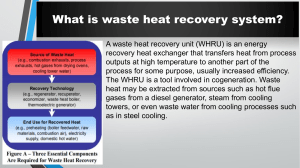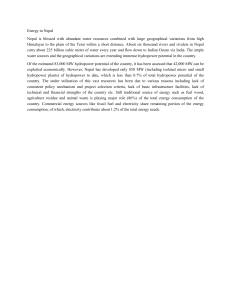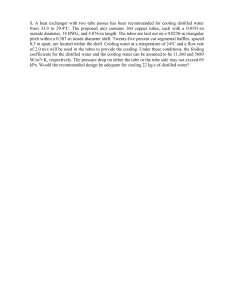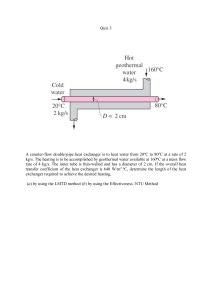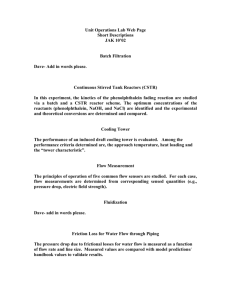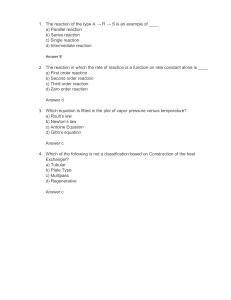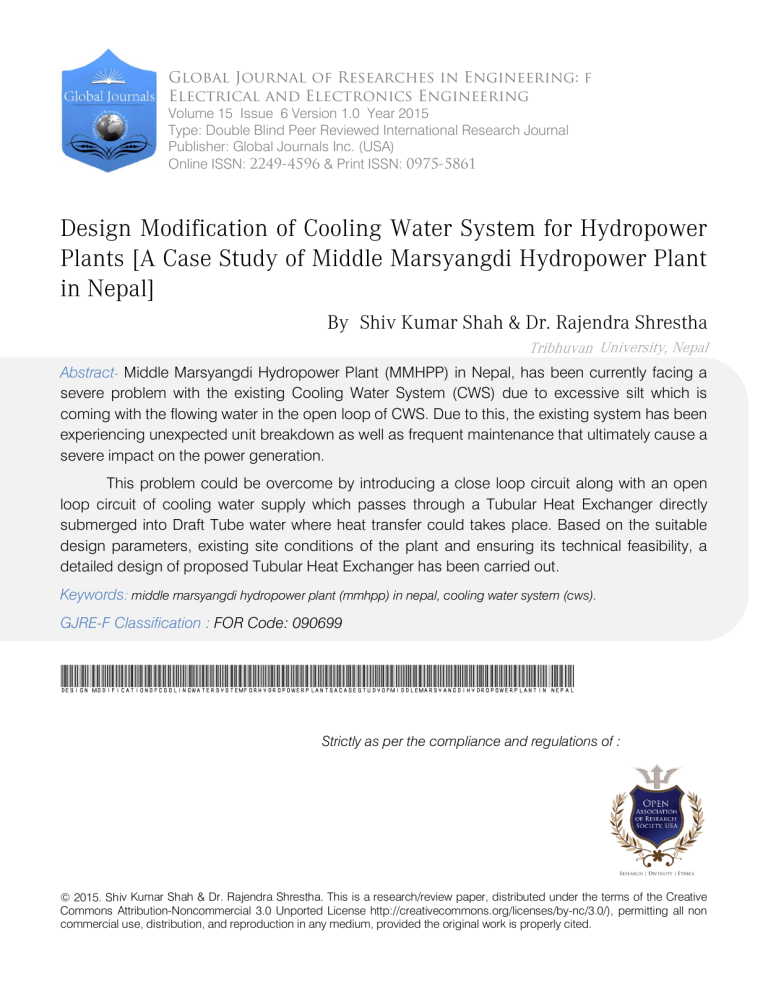
Global Journal of Researches in Engineering: F Electrical and Electronics Engineering Volume 15 Issue 6 Version 1.0 Year 2015 Type: Double Blind Peer Reviewed International Research Journal Publisher: Global Journals Inc. (USA) Online ISSN: 2249-4596 & Print ISSN: 0975-5861 Design Modification of Cooling Water System for Hydropower Plants [A Case Study of Middle Marsyangdi Hydropower Plant in Nepal] By Shiv Kumar Shah & Dr. Rajendra Shrestha Tribhuvan University, Nepal Abstract- Middle Marsyangdi Hydropower Plant (MMHPP) in Nepal, has been currently facing a severe problem with the existing Cooling Water System (CWS) due to excessive silt which is coming with the flowing water in the open loop of CWS. Due to this, the existing system has been experiencing unexpected unit breakdown as well as frequent maintenance that ultimately cause a severe impact on the power generation. This problem could be overcome by introducing a close loop circuit along with an open loop circuit of cooling water supply which passes through a Tubular Heat Exchanger directly submerged into Draft Tube water where heat transfer could takes place. Based on the suitable design parameters, existing site conditions of the plant and ensuring its technical feasibility, a detailed design of proposed Tubular Heat Exchanger has been carried out. Keywords: middle marsyangdi hydropower plant (mmhpp) in nepal, cooling water system (cws). GJRE-F Classification : FOR Code: 090699 Design ModificationofCoolingWaterSystemforHydropowerPlantsACaseStudyofMiddleMarsyangdiHydropowerPlantin Nepal Strictly as per the compliance and regulations of : © 2015. Shiv Kumar Shah & Dr. Rajendra Shrestha. This is a research/review paper, distributed under the terms of the Creative Commons Attribution-Noncommercial 3.0 Unported License http://creativecommons.org/licenses/by-nc/3.0/), permitting all non commercial use, distribution, and reproduction in any medium, provided the original work is properly cited. Design Modification of Cooling Water System for Hydropower Plants [A Case Study of Middle Marsyangdi Hydropower Plant in Nepal] Shiv Kumar Shah α & Dr. Rajendra Shrestha σ Keywords: middle marsyangdi hydropower (mmhpp) in nepal, cooling water system (cws). M I. plant Introduction iddle Marsyangdi Hydropower Plant is located in Lamjung district of Nepal with an installed capacity of 70 MW and annual design generation of 398 GWh. It has two turbine units together with other Auxiliary equipment. It was commissioned in 2008 with assistance from Government of Germany and Government of Nepal at an estimated cost of NRs. 30 billion. Discharge from the river is diverted through 5.2 Km long power tunnel constructed along the right-bank of Marsyangdiriver up to Sinudibar where the Powerhouse is situated. The major components of MMHPP consist of combined concrete gravity and rock fill dam with gated Spillway, three numbers of underground Desander caverns, Headrace Tunnel, Surge Tank, Valve Chamber, Penstock, Powerhouse, Tailrace Structure, two numbers of Power Transformer bays and a 132 kV outdoor sub-station. The entire generated power is being sent to the Integrated Nepal Power System (INPS) via MMHPP 132 kV transmission line. Author α: Electromechanical Design Division, Engineering Services Directorate, NEA. e-mail: shivshahmm@hotmail.com Author σ: Department of Mechanical Engineering, Pulchowk Campus, Institute of Engineering, Tribhuvan University, Nepal. e-mail: rsfluid@hotmail.com Year 9 Fig.1 : MMHPP Dam view from Downstream MMHPP has been facing a severe problem with the existing Cooling Water System (CWS) due to excessive silt which is coming with the flowing water in the open loop of CWS. This excessive silt is not only causing frequent unit breakdown but also damaging various components associated with cooling water Pumps, Heat Exchangers, Automatic Water Strainers, Pipings, Backwash Flushing and other accessories. Frequent replacement of these damaged parts is not only expensive but also time consuming process when the unit cannot generate power. Cleaning of Heat Exchangers, Automatic Water Strainers and Pipings requires considerable time and the maintenance crews have to be engaged from time to time in carrying out such maintenance during monsoon affecting the other scheduled maintenances. There is no doubt that the existing CWS of MMHPP is based on the latest and recent design and is better than the older system which exists at other large power plants such as Kaligandaki HPP, Marsyangdi HPP etc in Nepal. The older design incorporates only one loop i.e. open loop of Cooling Water Supply which either taps water directly from the Penstock (by gravity flow) or draws water from the Draft Tube by means of a water pump and supplies water to various consumers and sent back to the Draft Tube after cooling. Since MMHPP water from both sources is very dirty (full of silt) especially during monsoon, apart from damaging the associated components of CWS, it also damages the components associated with the various consumers at different locations where such dirty water is being supplied. The existing compact Plate Heat Exchanger provides highly effective cooling and is very useful with © 20 15 Global Journals Inc. (US) Global Journal of Researches in Engineering ( F ) Volume XV Issue VI Version I Nepal, has been currently facing a severe problem with the existing Cooling Water System (CWS) due to excessive silt which is coming with the flowing water in the open loop of CWS. Due to this, the existing system has been experiencing unex pected unit breakdown as well as frequent maintenance that ultimately cause a severe impact on the power generation. This problem could be overcome by introducing a close loop circuit along with an open loop circuit of cooling water supply which passes through a Tubular Heat Exchanger directly submerged into Draft Tube water where heat transfer could takes place. Based on the suitable design parameters, existing site conditions of the plant and ensuring its technical feasibility, a detailed design of proposed Tubular Heat Exchanger has been carried out. 2015 Abstract- Middle Marsyangdi Hydropower Plant (MMHPP) in Year 2015 Design Modification of Cooling Water System for Hydropower Plants [A Case Study of Middle Marsyangdi Hydropower Plant in Nepal] Global Journal of Researches in Engineering ( F ) Volume XV Issue VI Version I 10 clean water, however in context of Nepal, where most of the rivers are originated from Himalayas and have excessive quartzite sand, it is getting damaged quickly with sandy water as in the open loop of MMHPP. Hence the existing system is not serving the desired purposes effectively and necessitates some design modification for improved and reliable cooling system which could have better performance even with sandy water. The concept is to design a Heat Exchanger in the form of a cooling coil or a Shell and Tube type of Heat Exchanger (without Shell) and the entire unit shall be placed directly inside the Draft Tube or Tailrace chamber at appropriate location where optimum cooling effect for the close loop circulating water with minimum erosion of the unit can be achieved with the flowing water coming out of the runner exit via Draft Tube. Proper sizing and selection of material of the cooling coil, its configuration, connection to the existing system, appropriate location for easy installation shall be determined during the design phase of the entire unit is performed in detail installation work. Hence the main objective of this paper is to modify the design of existing Cooling Water Supply System of MMHPP in order to achieve improved plant reliability with reduced plant breakdown and maintenance costs. II. Research Methodology Review of existing design of CWS system of MMHPP was performed. All necessary design calculations associated with the modified system and proper analysis to ensure its technical and financial feasibility, were carried out. a) Review of Cooling Water System of Mmhpp) System Description MMHPP consists of FUNKE horizontally arranged Plate Heat Exchangers (PHE) is provided for exchanging heat between the closed and open circuit. It consists of a package of embossed heat transfer plates. The plates are assembled in a 180° angle to each other and provided with gaskets which seal the various flow gaps from the outside and separate the media from one another. Effective heat transfer, warm and cold media are normally led through the PHE in one-pass or multipass counter flow. Figure 2.1 : Heat Exchanger Plates in Separated Position © 2015 Global Journals Inc. (US) Middle Marsyangdi CWS is designed to be in function fully automatic. No manual interference is required. Cooling system is divided in two main cooling circuits and two water entrance supplies. In the first entrance for open circuit, water is taken from Penstock before turbine inlet valve and directed to one of two “Automatic self-cleaning Filter”. From this filter, water circulates through one of two “Heat Exchangers” and then discharges back to Draft Tube. In the second entrance for open circuit, water is pumped by two of two 50% capacity pumps, from Draft Tube and directed to one of two “Automatic self-cleaning Filter”. From this filter, water circulates through one of two “Heat Exchangers” and then discharges back to Draft Tube. Sediments and dirt are automatically directed to the Pump sump of the powerhouse from self-cleaning filters. In the closed circuit, water is circulated by one of two 100% capacity circulation pumps to following five consumers: • Governor Oil Cooler: 1.3 m³/h 1.5 m³/h • Turbine Guide Bearing: 14.1 m³/h • Combined Bearing: 3.9 m³/h • Generator Guide Bearing: • Generator Air Cooler : 119.2 m³/h All cooling water pressure, flow and temperature in both open and close circuits are controlled by governor and in case of malfunction, stand by unit is automatically activated to cover and keep turbine in function. For each closed circuit two circulation pumps with adjustable speed are provided, each one with 100% discharge capacity of the flow required under full load of the generator for the given temperature difference (350C to 280C).The discharge of one pump shall be not less than 40 lit/sec. The required head of the pump depends on the hydraulic resistance of all components within the closed circuit it uses motor capacity of 30 kW. For each open circuit two centrifugal pumps with constant speed are provided, each one with 50% discharge capacity of the flow required under full load of the generator for the given temperature difference (250C to 280C).The discharge of one pump shall be not less than 70 lit/sec. The required head of the pump depends on the hydraulic resistance of all components within the open circuit it uses motor capacity of 55 kW. Water flow velocity for each circuit shall not be higher than 2 m/s. Design Modification of Cooling Water System for Hydropower Plants [A Case Study of Middle Marsyangdi Hydropower Plant in Nepal] HEAT EXCHANGER NON RETURN VALVE AUTOMATIC WATER STRAINER NON RETURN VALVE PUMP M COMBINED BEARING TURBINE GUIDE BEARING GOVERNOR OILCOOLER M NORMALLY OPEN RETURN WATER BACK TO TAILRACE GENERATOR GUIDE BEARING MOTOR OPERATED VALVE BACK-UP SUPPLY MAIN SUPPLY SPIRAL CASING PENSTOCK DRAFT TUBE CLOSE LOOP Unit/Plant tripping outage and maintenance related specific data with respect of Cooling Water System collected from MMHPP for the years 2010, 2011 & 2012 had been thoroughly reviewed and analyzed. The maintenance frequency and duration of the entire CWS (Heat Exchanger, Automatic Water Strainer, Valves, Backwash Flushing System, Pipings etc.) had been found to be considerably higher than their usual levels. OPEN LOOP 7 No. of Unit Trips Maintenance Hours 6 No. of Trips 4 11 3 2 1 0 -1 0 1 2 3 4 5 6 7 8 9 10 11 12 Months Fig.3.1 : Monthly tripping and maintenance hrs 2010 25 No. of Unit Trips Maintenance Hours 20 No. of Trips b) Major Maintenance Works Carried out in the Cws of Mmhpp During the years 2010, 2011 & 2012, mainly following major maintenance activities had been carried out in the Cooling Water System of MMHPP: • Automatic Water Strainer (AWS) cleaning and maintenance; • Heat Exchanger & Plates cleaning and maintenance; • Replacement of ruptured Heat Exchanger Plates with the new ones; • Cleaning and maintenance of Backwash filter with replacement of Diaphragm seal; • Replacement of complete set Backwash shut-off valve of AWS and Backwash filter transformer; • Cleaning and maintenance of Backwash flushing system; • Cooling Water Inlet/Outlet Orifice plates cleaning and maintenance; • Replacement of old tubes for AWS with the new ones; • Removing mud and sand from motor operated valves of AWS; • Replacement of Shaft Coupling for Cooling Water Pump; • Repair, maintenance and replacement of Cooling Water Pump Impeller; • Cleaning and maintenance of open circuit cooling water pipes and valves; 5 15 10 5 0 0 -5 1 2 3 4 5 6 7 Months 8 9 10 11 12 Fig.3.2 : Monthly tripping and maintenance hrs 2011 5 4 No. of Trips Figure.3 : Existing Cooling Water System with Plate Heat Exchanger at MMHPP Despite of its innovative and compact design, the service of existing PHE has been severely affected by excessive silt present in Marsyangdi River. Hence, various components are getting damaged quickly with sandy water flowing in the CWS open loop of MMHPP. Water strainer also needs frequent repair due to sandy water. 2015 GENERATOR AIR COOLER Year NORMALLY OPEN No. of Unit Trips 3 2 1 0 -1 0 1 2 3 4 5 6 7 8 9 10 11 12 Months Fig.3.3 : Monthly tripping and maintenance hrs 2012 © 20 15 Global Journals Inc. (US) Global Journal of Researches in Engineering ( F ) Volume XV Issue VI Version I CIRCULATION M PUMP VARIOUS CONSUMERS Data analysis and Processing III. EXISTING CWS AT MIDDLE MARSYANGDI HYDROPOWER PLANT Design Modification of Cooling Water System for Hydropower Plants [A Case Study of Middle Marsyangdi Hydropower Plant in Nepal] 2015 No. of Trips/Maintenance Hours 25 Monthly Trippings and Maintenance Hours 2010, 2011, 2012 No. of Unit Trips 15 Maintenance Hours 10 5 0 0 2 4 6 8 10 12 14 16 18 20 22 24 26 28 30 32 34 36 -5 Year Global Journal of Researches in Engineering ( F ) Volume XV Issue VI Version I 12 20 Months Fig. 3.4: Monthly tripping and maintenance hrs 2010, 2011 and 2012 All the above graphs show that most of the tripping has occurred during monsoon and longer hours are spent on maintenance during monsoon in the cooling system. The above graphs reveal that the problem occurring in the Cooling Water System has lead to Unit/Plant breakdown resulting in significant outage time. These yearly outage hours as calculated are much above than the normal outage hours. The total annual energy loss by the Plant and monitory loss of NEA due to frequent problems occurring in the CWS of MMHPP is very high. Significant amount of energy has been lost every year due to problems occurring in the existing CWS of MMHPP resulting in a huge amount of monitory loss to the organization. The loss of energy and associated energy costs due to Unit/Plant breakdown has been found to be significantly high. IV. Design of Submersed Tubular Heat Exchanger Referring to the Operation and Maintenance manual of CWS, MMHPP, following major Design Parameters have been identified to be considered for designing the Proposed Tubular Heat Exchanger and installed in Draft Tube of the power plant. • Quantity of water flowing inside the closed circuit pipe; Qi (not less than) = 40 lit/s (≅144 m3/h) • Flow velocity inside pipe should not be higher than 2 m/s; Vi = 2 m/s • Temperature of hot water coming out of Consumers; To = 35 0C • Temperature of cold water entering into Consumers; Ti = 28 0C • Temperature of Draft Tube water; Td = 11 0C • Flow velocity inside the Draft Tube; Vo = 1.5 m/s • Specific Heat Capacity of water at average temperature 31.5 0C; Cp = 4.175 KJ/Kg0C © 2015 Global Journals Inc. (US) a) Design Considerations And Underlying Theories Case being as forced convection, we should analytically consider the problem of heat transfer in fully developed laminar or turbulent tube flow as the case may be. The cases of underdeveloped laminar flow, flow systems where the fluid properties vary widely with temperature, and turbulent-flow systems are considerably more complicated but are of very important practical interest in the design of heat exchangers and associated heat-transfer equipment. These more complicated problems may sometimes be solved analytically, but the solutions, when possible, are very tedious. For the design and engineering purposes, empirical correlations are usually of greatest practical utility. b) Flow Inside Tubes Q m, Cp Flow dx Th1 1 2 Th2 x L Figure. 4.1 :Total Heat Transfer in terms of Bulktemperature Difference For the inside tube flow, the total energy lost can be expressed in terms of bulk-temperature difference by – Q = m ×Cp× (Th1−Th2) Where Cp is reasonably constant over the length and Q= Heat transfer rate m= Mass flow rate of hot fluid flowing inside tube Cp= Specific heat capacity of hot fluid flowing inside tube Th1= Temperature of hot fluid at inlet Th2= Temperature of hot fluid at outlet In some differential length dx the heat lost dq can be expressed either in terms of a bulk-temperature difference or in terms of the heat-transfer coefficient: dQ= m ×Cp×dTh = h (2πρ) dx (Tw – Th) Where Tw and Th are the wall and bulk temperatures at the particular x location. The total heat transfer can also be expressed as – Q = h × A × (Tw – Th)av = h × A × (∆T)m Where h= Heat transfer coefficient A= Heat transfer surface area (∆T)m = Logarithmic Mean Temperature Difference = (Tw – Th)av c) Taking 1.5” Nominal Diameter Mild Steel Tube [Table A-11, “Heat Transfer” by J. P. Holman] Design Modification of Cooling Water System for Hydropower Plants [A Case Study of Middle Marsyangdi Hydropower Plant in Nepal] ∴Nud = 0.027 × (73,867)0.805× (0.076)0.33 = 0.023 ×8300.5× 0.42724 = 81.56 ∴ho = 91,261 W/m2 0C Now, the overall heat transfer coefficient (Uo) can be determined by using the equation 2−15 or 2−16 on Page no. 35 of “Heat Transfer” by J. P. Holman, eighth edition. 𝐔𝐔𝐨𝐨 = = 83,457 = (2 ×0.040894)/(9.8 × 10−7) Since Re > 4000, the flow inside tube is turbulent. Prandtl Number (Pr) = (µ×Cp)/k = (9.8 × 10−4× 4.18 × 103)/54 = 0.076 For fully developed turbulent flow in circular tubes as stated in “Heat and Mass Transfer” by R. K. Rajput, Article 7.5.4 (Page 466) – “Turbulent Flow in Tubes”, equation 7.164, Nusselt number proposed by Mc Adams: Nud = 0.023 × (Re)0.8× (Pr)n Where, n = 0.3 for cooling (which is the case) ∴Nud = 0.023 × (83457)0.8× (0.076)0.3 = 0.023 ×8653× 0.461577 = 91.86 Also, Nud = (hi× Di) / k or, hi = (Nud× k) / Di = (91.86× 54) / 0.040894 = 121,300 𝐔𝐔𝐨𝐨 = e) Turbulent Flow Over Cylinders To calculate now h2, let’s first verify whether the flow over cylinders is Laminar or Turbulent. Reynolds Number (Re) = (Vo× Do) /ν = (1.5 ×0.04826)/(9.8 × 10−7) = 73,867 Since Re > 4000, the flow outside tube is turbulent. Nud = C × (Re)n× (Pr)1/3 Where C and n are constants and its value corresponding to Re = 73,867, the values for C and n 𝟏𝟏 𝐫𝐫 𝐀𝐀𝐨𝐨 × 𝐥𝐥𝐥𝐥 ( 𝐨𝐨 ) 𝐀𝐀𝐨𝐨 𝟏𝟏 𝟏𝟏 𝐫𝐫𝐢𝐢 + + � � + 𝐀𝐀𝐢𝐢 𝐡𝐡𝐢𝐢 𝐡𝐡𝐨𝐨 𝟐𝟐π𝐤𝐤𝐤𝐤 Where, Uo = Overall heat transfer coefficient Ao = Outside surface area of tube = Inside surface area of tube Ai hi = Heat transfer coefficient for water flowing inside tube = Heat transfer coefficient for water flowing over ho Cylinder = Outside diameter of tube ro ri = Inside diameter of tube = Thermal conductivity of mild steel k Here, hi = 121,300W/m2 0C ho = 91,261W/m2 0C ro = 0.02413 m ri = 0.020447 m ∴hi = 121,300 W/m2 0C Prandtl Number (Pr) = (µ×Cp)/k = (9.8 × 10−4× 4.18 × 103)/54 = 0.076 For fully developed turbulent flow over cylindrical tubes as stated in “Heat and Mass Transfer” by R. K. Rajput, Article 7.5.5 (Page no. 467) – “Turbulent Flow over Cylinders”, equation 7.169, Nusselt number is given by: = (Nud× k) / = 𝐔𝐔 𝐨𝐨 = � 𝟏𝟏 𝐫𝐫 𝐀𝐀𝐨𝐨 × 𝐥𝐥𝐥𝐥 ( 𝐨𝐨 ) 𝐀𝐀𝐨𝐨 𝟏𝟏 𝟏𝟏 𝐫𝐫𝐢𝐢 + + � �× 𝐀𝐀𝐢𝐢 𝐡𝐡𝐢𝐢 𝐡𝐡𝐨𝐨 𝟐𝟐π𝐤𝐤𝐤𝐤 𝟏𝟏 𝐫𝐫 𝐫𝐫𝐨𝐨 × 𝐥𝐥𝐥𝐥 ( 𝐨𝐨 ) 𝐫𝐫𝐨𝐨 𝟏𝟏 𝟏𝟏 𝐫𝐫𝐢𝐢 � �× + + 𝐫𝐫𝐢𝐢 𝐡𝐡𝐢𝐢 𝐡𝐡𝐨𝐨 𝐤𝐤 𝟏𝟏 𝟎𝟎. 𝟎𝟎𝟎𝟎𝟎𝟎𝟎𝟎𝟎𝟎 𝟎𝟎. 𝟎𝟎𝟎𝟎𝟎𝟎𝟎𝟎𝟎𝟎 × 𝐥𝐥𝐥𝐥 ( ) 𝟏𝟏 𝟎𝟎. 𝟎𝟎𝟎𝟎𝟎𝟎𝟎𝟎𝟎𝟎 𝟎𝟎. 𝟎𝟎𝟎𝟎𝟎𝟎𝟎𝟎𝟎𝟎𝟎𝟎 + 𝟏𝟏 �× + 𝟏𝟏𝟏𝟏𝟏𝟏𝟏𝟏𝟏𝟏𝟏𝟏 𝟗𝟗𝟗𝟗𝟗𝟗𝟗𝟗𝟗𝟗 𝟎𝟎. 𝟎𝟎𝟎𝟎𝟎𝟎𝟎𝟎𝟎𝟎𝟎𝟎 𝟓𝟓𝟓𝟓 Uo = 10,561 W/m2 0C The overall heat transfer coefficient is also related as: 𝐀𝐀𝐬𝐬 = 𝐐𝐐 𝟏𝟏𝟏𝟏𝟗𝟗𝟗𝟗 × 𝟏𝟏𝟎𝟎𝟎𝟎 = = 𝟓𝟓. 𝟎𝟎𝟓𝟓𝟎𝟎 𝐦𝐦𝟐𝟐 𝟏𝟏𝟎𝟎𝟓𝟓𝟗𝟗𝟏𝟏 × 𝟐𝟐𝟎𝟎. 𝟎𝟎 𝐔𝐔𝐨𝐨 × (∆𝐓𝐓)𝐦𝐦 © 20 15 Global Journals Inc. (US) 2015 = (ho× Do) / kor, ho Also, Nud Do = (81.56× 54) / 0.04826 = 91,261 Year d) Flow Inside Tube Reynolds Number (Re) = (Vi× Di) /ν come to be 0.027 and 0.805 respectively from this Table. Hence, 13 Global Journal of Researches in Engineering ( F ) Volume XV Issue VI Version I Calculation were performed for various sizes and best suitable is found for following parameters: Hence, if 1” diameter and 1.5 m long tubes are selected, 33 pieces will be required. Increased number of tubes leads to bulky heat exchanger with bigger flanges. Since the objective is to design optimum size Heat Exchanger, 1.5” mild steel tube is considered to reduce the overall size of the Heat Exchanger in Case II below: Nominal Diameter (Dn) = 1.5” = 0.0381 m Inside Diameter (Di) = 1.61” = 0.040894 m, Inner Radius (ri) = 0.020447 m Outside Diameter (Do) = 1.9” = 0.04826 m, Outer Radius (ro) = 0.02413 m Design Modification of Cooling Water System for Hydropower Plants [A Case Study of Middle Marsyangdi Hydropower Plant in Nepal] Year 2015 𝐍𝐍 = Global Journal of Researches in Engineering ( F ) Volume XV Issue VI Version I 14 𝟓𝟓. 𝟎𝟎𝟓𝟓𝟎𝟎 𝐀𝐀𝐬𝐬 = = 𝟐𝟐𝟎𝟎. 𝟗𝟗𝟎𝟎 𝟐𝟐π𝐫𝐫𝐨𝐨 × 𝐤𝐤 𝟐𝟐π × 𝟎𝟎. 𝟎𝟎𝟐𝟐𝟎𝟎𝟏𝟏𝟎𝟎 × 𝟏𝟏. 𝟓𝟓 ≅ 𝟐𝟐𝟎𝟎 𝐏𝐏𝐏𝐏𝐬𝐬. In this case with 1.5” diameter and 1.5 m long tube, we have found that only 24 pieces are enough to transfer the desired heat from the flowing water through tubes for the desired inlet and outlet temperatures. Such a reduced number of tubes leads to comparatively smaller size and compact Heat Exchanger and hence cheaper in price. Hence second option i. e. 1.5”φ× 1.5 m × 24 pieces mild steel tubes for making the required Heat Exchanger was considered. f) Design Summary Tube material: Mild steel Tube diameter: 1.5” Length of each tube: 1.5 m Number of tubes required: 24 Tube spacing: 38 mm Heat Exchanger flange material: Mild steel Inlet and outlet dome material: Mild steel Inlet and outlet flange thickness: 16 mm Inlet and outlet dome thickness: 16 mm Main inlet and outlet pipe material: Mild steel Inlet and outlet 900 bends material: Mild steel Inlet and outlet 900 bends size (φ): 200 mm Inlet and outlet pipe material: Mild steel Inlet and outlet pipe size (φ): 200 mm Inlet and outlet flange material: Mild steel Fig. 4.2 : Dimensional Drawing of Tubular Heat Exchanger g) Locating the Tubular Heat Exchanger Heat Exchanger, due to limited access to the Draft Tube of MMHPP, it has been designed of smaller © 2015 Global Journals Inc. (US) size but enough to transfer the desired quantity of heat from the hot water coming from the various consumers. Based on the existing CWS configuration, location, arrangements, space limitations and reviewing the relevant Mechanical as well as Civil As-Built drawings of MMHPP, the following figures are identified for the proposed modification works. The connections are shown by the Conceptual Drawing in Figure 4.3 below. h) Advantages of Locating the Tubular he Beside the Side Wall of Draft Tube Since the existing pipe aligns along the side wall, shorter pipe length is required by installing the HE Unit in the same alignment hence less loss in pipes and bends occur. No obstruction to free flow of draft tube water is achieved. No direct impact (hitting) of water and silt over the Unit protecting it against any physical damages. PROPOSED CONNECTIONS AND ARRANGEMENTS OF EXISTING CLOSED LOOP PIPING WITH TUBULAR HEAT EXCHANGER FLOW COLD WATER OUT HOT WATER IN FLOW Thus, total surface area required to transfer the desired amount of heat with 1” mild steel tube comes to be 5.453 m2. Because of space limitation inside the Draft Tube, 1.5 m long tube was assumed. Hence, number of 1.5 m long mild steel tubes; N required can be calculated as: 𝐀𝐀𝐬𝐬 = 𝟐𝟐π𝐫𝐫𝐨𝐨 × 𝐤𝐤 × N RCC SLAB TO BE DRILLED TO INSERT NEW 200 mm DIA PIPE EXISTING HEAT EXCHANGER SUBMERGED HEAT EXCHANGER IN OUT FREE FLOW DRAFT TUBE WATER OPEN LOOP WATER SUPPLY Fig. 4.3 : Proposed Connection of New Heat Exchanger (Conceptual) i) Limitations of the New System Chances of Tubular Heat Exchanger wearing fast in case of higher silt level in the tailrace water during monsoon (unless until the system is being tested). Replacement might be comparatively time taking and little more complicated. Figure. 4.4 : Cooling Water Flow Diagram for New Proposed System Design Modification of Cooling Water System for Hydropower Plants [A Case Study of Middle Marsyangdi Hydropower Plant in Nepal] V. Conclusions 2015 1. Holman, J. P., 1997, Heat Transfer Eighth edition, McGraw-Hill, Inc. New York, ISBN 0-07-844785-2. 2. Rajput, R. K., 2006, Heat and Mass Transfer in SI Units, S. Chand & Company Ltd., New Delhi, ISBN 81-219-2617-3. 3. Wolverine Tube Heat Transfer Data Book Chapter 2.2: Basic Equation for Heat Exchanger Design. 4. Dunn D. J., 2001, Heat Transfer Tutorial 3 Advanced Studies. 5. Singh R. Paul, Winter2006, Design of a Tubular Heat Exchanger. 6. Heat Exchanger Design, World Academy of Science, Engineering and Technology 46-2008. 7. Voith Hydro GmbH Germany (Lot M Contractor for Middle Marsyangdi Hydropower Project), 2008, 15 Operation Maintenance Manual. 8. Voith Siemens GmbH Germany (Lot M Contractor for Marsyangdi Hydropower Project), 1989, Instruction Manual. 9. Alstom Energy GmbH France, 2001 Operation Maintenance Manual. 10. Middle Marsyangdi Hydropower Plant, 2008, As Built Drawings and Flow Diagram. 11. Marsyangdi Hydropower Plant, 1989, As Built Drawings and Flow Diagram. 12. Kaligandaki – ‘A’ Hydropower Plant, 2001,Flow Diagram. 13. Plate Heat Exchanger (FUNKE) related information and Photos from website: www.funke heatexchnger.com. Year i. Payback Period based on both Energy Loss and Potential Savings a. Implementation Costs The total costs associated with the entire modification works = NRs. 2.345 million Therefore, Implementation Costs =NRs. 2.345 million b. Total Annual Savings Savings on frequent Unit/Plant Breakdown = NRs. 7.1 million Savings on Spare Parts Consumption = NRs. 1.4 million Savings on Penstock Water = NRs. 5.4 million Therefore, Total Annual Savings = NRs. 13.9 million Therefore, Payback Period = Implementation Costs/Total Annual Savings = (2.345 × 12 months)/13.9≈2 months Thus, the Payback Period comes to be just two months if we consider the benefits that are achieved with new system which otherwise is being lost due to problems occurring in the existing CWS as well as the potential savings that can be achieved from saving on Penstock water. References Références Referencias Global Journal of Researches in Engineering ( F ) Volume XV Issue VI Version I Financial Analysis Based on the Price Schedule received from Om Shakti Engineering Pvt. Ltd., Gothatar-9, Kathmandu and the Costs associated to entire modification works as determined, financial analysis for implementing the proposed modification has been presented below to confirm the economical viability of the system. j) Based on detailed study, analysis and design, the proposed design modification of the CWS, MMHPP sounds technically feasible. This new system would generate about 540,000 kWh of additional energy annually due to potential saving in Penstock water. On the other hand, spare parts consumption is expected to be reduced significantly. Consequently, new system will help to generate and feed sustainable power to the national grid in a much reliable way. Further, there is a significant reduction in construction costs for not requiring Draft Tube Pumps and Accessories for a new Hydropower Project. Tubular Heat Exchanger, which is the main damageable component of the system, costs much less as compare to the existing Plate Heat Exchanger. It is expected that it would reduce plant breakdown time considerably which has been currently spent because of problems in the existing CWS of MMHPP. The purpose of this research study is not just limited for the betterment of NEA in Nepal but also it is highly recommended to implement this proposed new system in the hydropower utilities around the globe. © 20 15 Global Journals Inc. (US) Year 2015 Design Modification of Cooling Water System for Hydropower Plants [A Case Study of Middle Marsyangdi Hydropower Plant in Nepal] Global Journal of Researches in Engineering ( F ) Volume XV Issue VI Version I 16 This page is intentionally left blank © 2015 Global Journals Inc. (US)
